Evaluating Security Challenges and Solutions in Cloud Computing
VerifiedAdded on 2023/06/13
|15
|3958
|481
Report
AI Summary
This report provides an overview of cloud computing security, focusing on the threats and preventive methods. It begins by highlighting the importance of cloud security, especially concerning data breaches and the security policies of cloud providers. The report then delves into the technologies involved in cloud computing, such as virtualization, distributed mass storage, and parallel programming models, explaining their applications. It identifies challenges like data breaches, insufficient access control, and insecure APIs, as well as vulnerabilities such as system exploits and account hijacking. The discussion identifies gaps in addressing shared dangers, user control, and data transparency. The report concludes by suggesting future research directions, emphasizing the need for multifaceted authentication, intrusion detection systems, and improved data control mechanisms, ultimately aiming to enhance the security of cloud computing for both users and providers. Desklib offers this document along with a wide range of study resources.
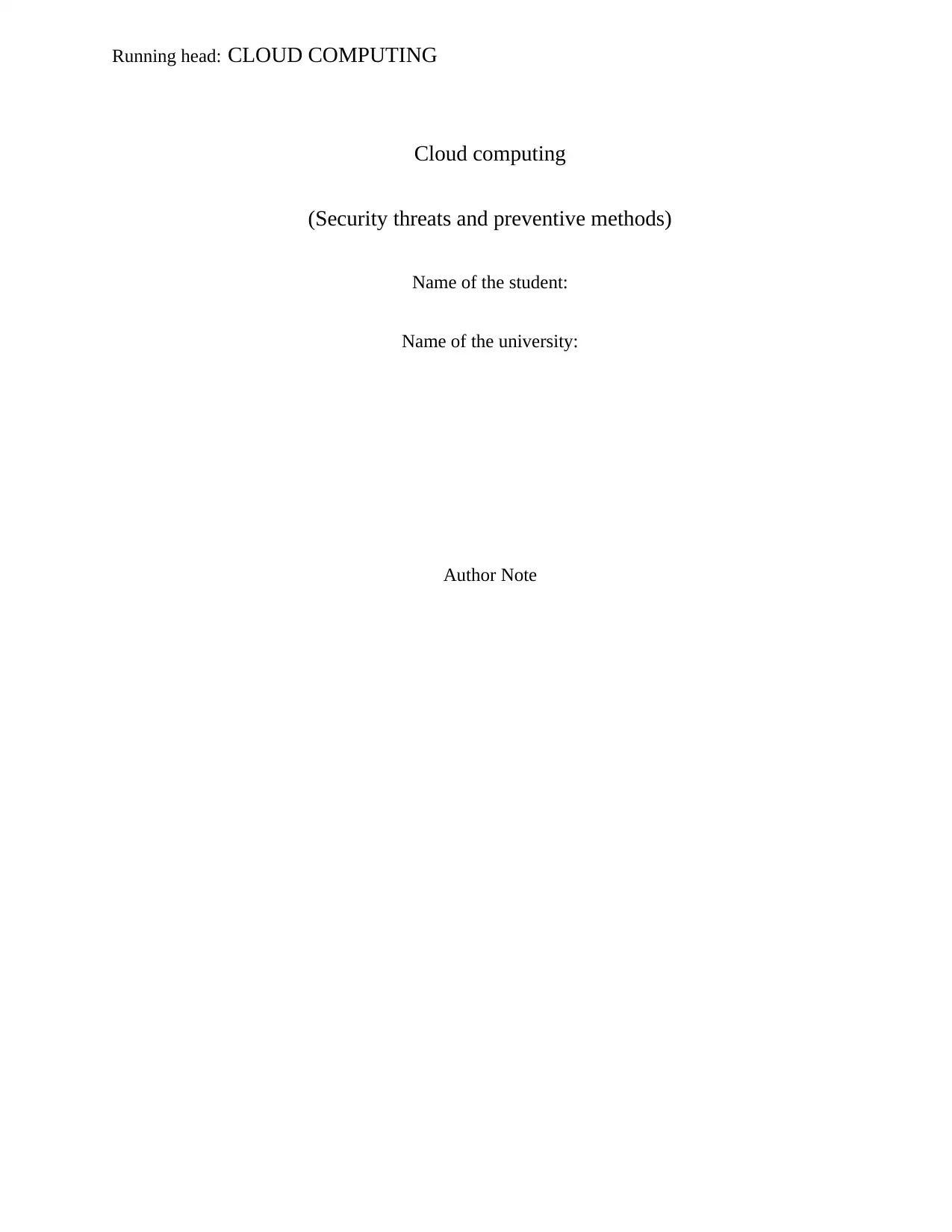
Running head: CLOUD COMPUTING
Cloud computing
(Security threats and preventive methods)
Name of the student:
Name of the university:
Author Note
Cloud computing
(Security threats and preventive methods)
Name of the student:
Name of the university:
Author Note
Paraphrase This Document
Need a fresh take? Get an instant paraphrase of this document with our AI Paraphraser
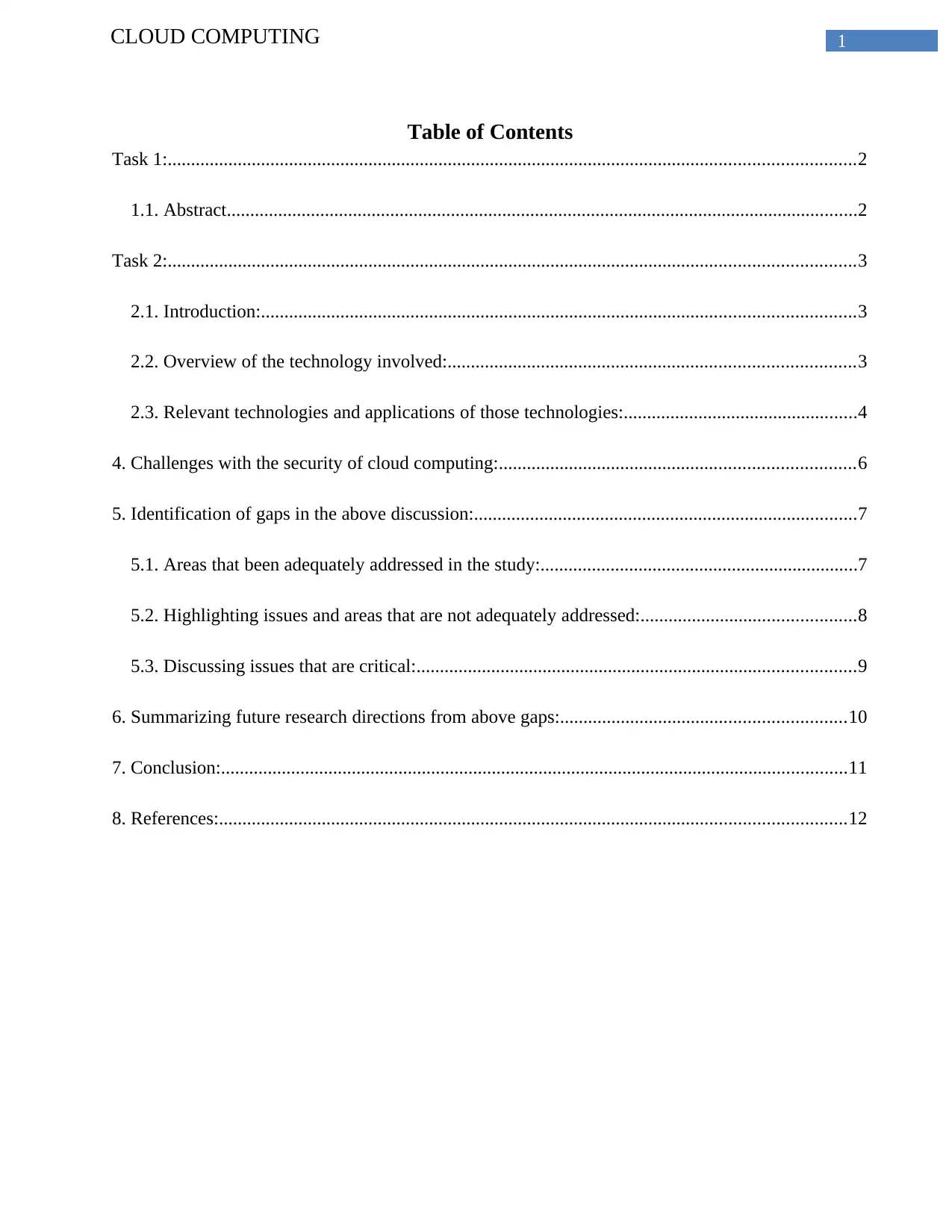
1CLOUD COMPUTING
Table of Contents
Task 1:...................................................................................................................................................2
1.1. Abstract.......................................................................................................................................2
Task 2:...................................................................................................................................................3
2.1. Introduction:...............................................................................................................................3
2.2. Overview of the technology involved:.......................................................................................3
2.3. Relevant technologies and applications of those technologies:..................................................4
4. Challenges with the security of cloud computing:............................................................................6
5. Identification of gaps in the above discussion:..................................................................................7
5.1. Areas that been adequately addressed in the study:....................................................................7
5.2. Highlighting issues and areas that are not adequately addressed:..............................................8
5.3. Discussing issues that are critical:..............................................................................................9
6. Summarizing future research directions from above gaps:.............................................................10
7. Conclusion:......................................................................................................................................11
8. References:......................................................................................................................................12
Table of Contents
Task 1:...................................................................................................................................................2
1.1. Abstract.......................................................................................................................................2
Task 2:...................................................................................................................................................3
2.1. Introduction:...............................................................................................................................3
2.2. Overview of the technology involved:.......................................................................................3
2.3. Relevant technologies and applications of those technologies:..................................................4
4. Challenges with the security of cloud computing:............................................................................6
5. Identification of gaps in the above discussion:..................................................................................7
5.1. Areas that been adequately addressed in the study:....................................................................7
5.2. Highlighting issues and areas that are not adequately addressed:..............................................8
5.3. Discussing issues that are critical:..............................................................................................9
6. Summarizing future research directions from above gaps:.............................................................10
7. Conclusion:......................................................................................................................................11
8. References:......................................................................................................................................12
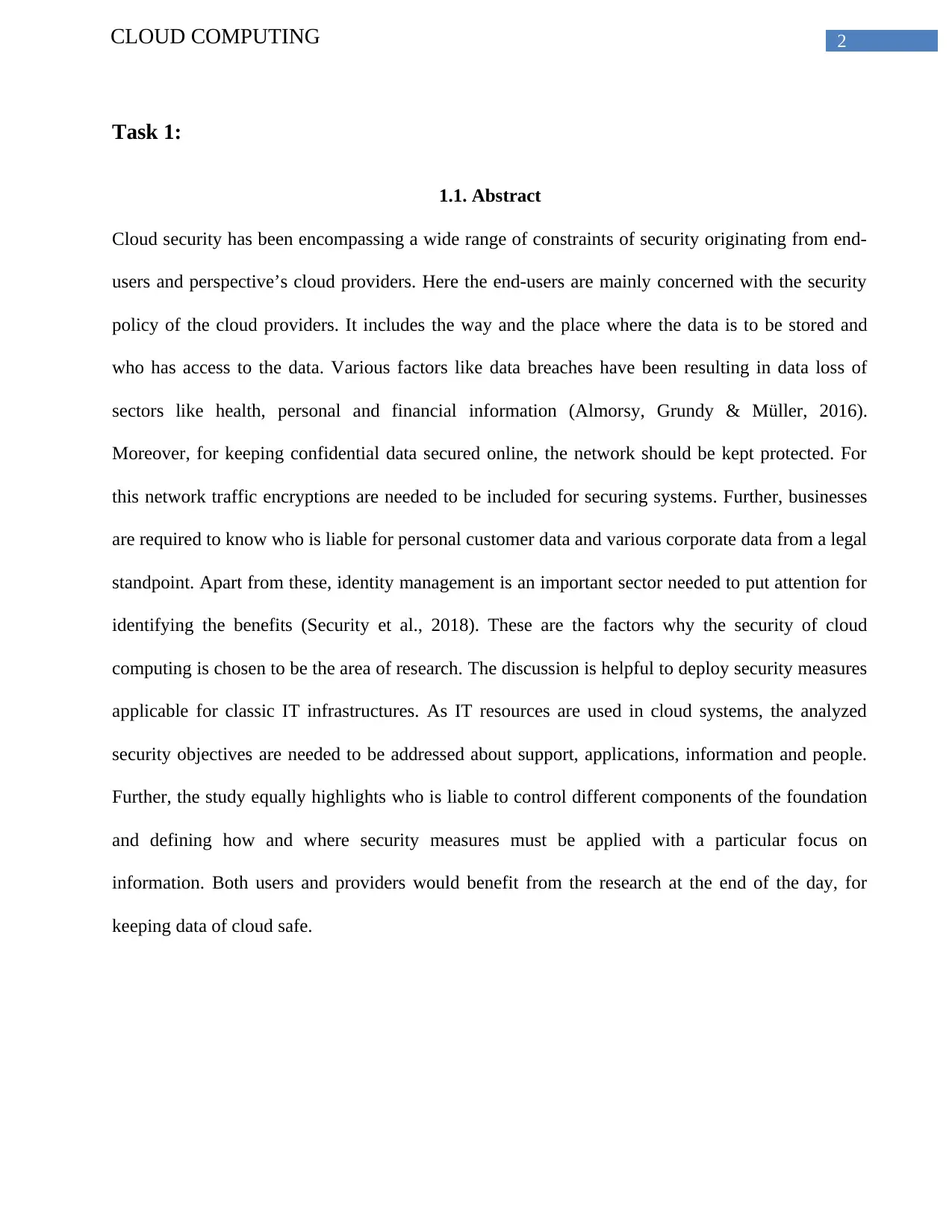
2CLOUD COMPUTING
Task 1:
1.1. Abstract
Cloud security has been encompassing a wide range of constraints of security originating from end-
users and perspective’s cloud providers. Here the end-users are mainly concerned with the security
policy of the cloud providers. It includes the way and the place where the data is to be stored and
who has access to the data. Various factors like data breaches have been resulting in data loss of
sectors like health, personal and financial information (Almorsy, Grundy & Müller, 2016).
Moreover, for keeping confidential data secured online, the network should be kept protected. For
this network traffic encryptions are needed to be included for securing systems. Further, businesses
are required to know who is liable for personal customer data and various corporate data from a legal
standpoint. Apart from these, identity management is an important sector needed to put attention for
identifying the benefits (Security et al., 2018). These are the factors why the security of cloud
computing is chosen to be the area of research. The discussion is helpful to deploy security measures
applicable for classic IT infrastructures. As IT resources are used in cloud systems, the analyzed
security objectives are needed to be addressed about support, applications, information and people.
Further, the study equally highlights who is liable to control different components of the foundation
and defining how and where security measures must be applied with a particular focus on
information. Both users and providers would benefit from the research at the end of the day, for
keeping data of cloud safe.
Task 1:
1.1. Abstract
Cloud security has been encompassing a wide range of constraints of security originating from end-
users and perspective’s cloud providers. Here the end-users are mainly concerned with the security
policy of the cloud providers. It includes the way and the place where the data is to be stored and
who has access to the data. Various factors like data breaches have been resulting in data loss of
sectors like health, personal and financial information (Almorsy, Grundy & Müller, 2016).
Moreover, for keeping confidential data secured online, the network should be kept protected. For
this network traffic encryptions are needed to be included for securing systems. Further, businesses
are required to know who is liable for personal customer data and various corporate data from a legal
standpoint. Apart from these, identity management is an important sector needed to put attention for
identifying the benefits (Security et al., 2018). These are the factors why the security of cloud
computing is chosen to be the area of research. The discussion is helpful to deploy security measures
applicable for classic IT infrastructures. As IT resources are used in cloud systems, the analyzed
security objectives are needed to be addressed about support, applications, information and people.
Further, the study equally highlights who is liable to control different components of the foundation
and defining how and where security measures must be applied with a particular focus on
information. Both users and providers would benefit from the research at the end of the day, for
keeping data of cloud safe.
⊘ This is a preview!⊘
Do you want full access?
Subscribe today to unlock all pages.

Trusted by 1+ million students worldwide
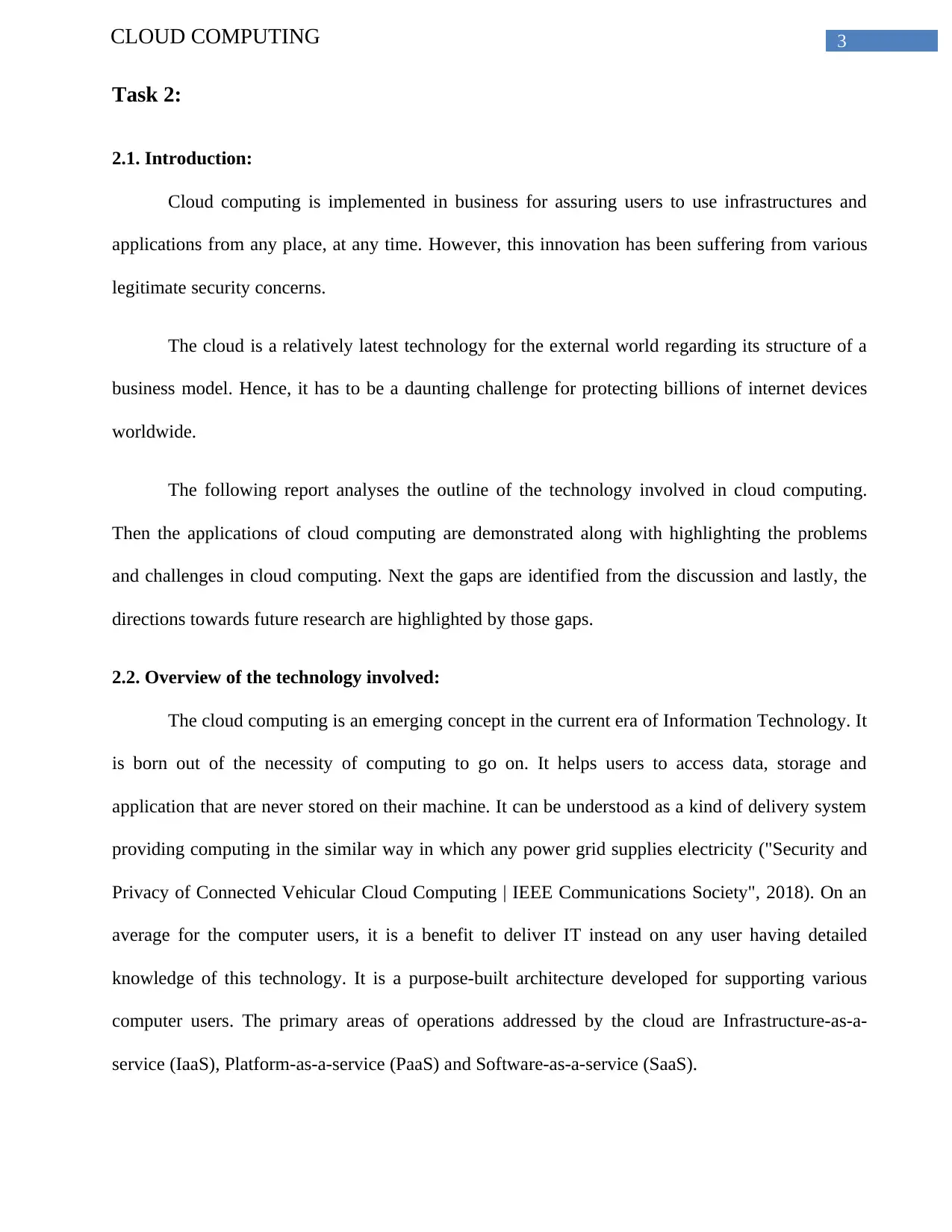
3CLOUD COMPUTING
Task 2:
2.1. Introduction:
Cloud computing is implemented in business for assuring users to use infrastructures and
applications from any place, at any time. However, this innovation has been suffering from various
legitimate security concerns.
The cloud is a relatively latest technology for the external world regarding its structure of a
business model. Hence, it has to be a daunting challenge for protecting billions of internet devices
worldwide.
The following report analyses the outline of the technology involved in cloud computing.
Then the applications of cloud computing are demonstrated along with highlighting the problems
and challenges in cloud computing. Next the gaps are identified from the discussion and lastly, the
directions towards future research are highlighted by those gaps.
2.2. Overview of the technology involved:
The cloud computing is an emerging concept in the current era of Information Technology. It
is born out of the necessity of computing to go on. It helps users to access data, storage and
application that are never stored on their machine. It can be understood as a kind of delivery system
providing computing in the similar way in which any power grid supplies electricity ("Security and
Privacy of Connected Vehicular Cloud Computing | IEEE Communications Society", 2018). On an
average for the computer users, it is a benefit to deliver IT instead on any user having detailed
knowledge of this technology. It is a purpose-built architecture developed for supporting various
computer users. The primary areas of operations addressed by the cloud are Infrastructure-as-a-
service (IaaS), Platform-as-a-service (PaaS) and Software-as-a-service (SaaS).
Task 2:
2.1. Introduction:
Cloud computing is implemented in business for assuring users to use infrastructures and
applications from any place, at any time. However, this innovation has been suffering from various
legitimate security concerns.
The cloud is a relatively latest technology for the external world regarding its structure of a
business model. Hence, it has to be a daunting challenge for protecting billions of internet devices
worldwide.
The following report analyses the outline of the technology involved in cloud computing.
Then the applications of cloud computing are demonstrated along with highlighting the problems
and challenges in cloud computing. Next the gaps are identified from the discussion and lastly, the
directions towards future research are highlighted by those gaps.
2.2. Overview of the technology involved:
The cloud computing is an emerging concept in the current era of Information Technology. It
is born out of the necessity of computing to go on. It helps users to access data, storage and
application that are never stored on their machine. It can be understood as a kind of delivery system
providing computing in the similar way in which any power grid supplies electricity ("Security and
Privacy of Connected Vehicular Cloud Computing | IEEE Communications Society", 2018). On an
average for the computer users, it is a benefit to deliver IT instead on any user having detailed
knowledge of this technology. It is a purpose-built architecture developed for supporting various
computer users. The primary areas of operations addressed by the cloud are Infrastructure-as-a-
service (IaaS), Platform-as-a-service (PaaS) and Software-as-a-service (SaaS).
Paraphrase This Document
Need a fresh take? Get an instant paraphrase of this document with our AI Paraphraser
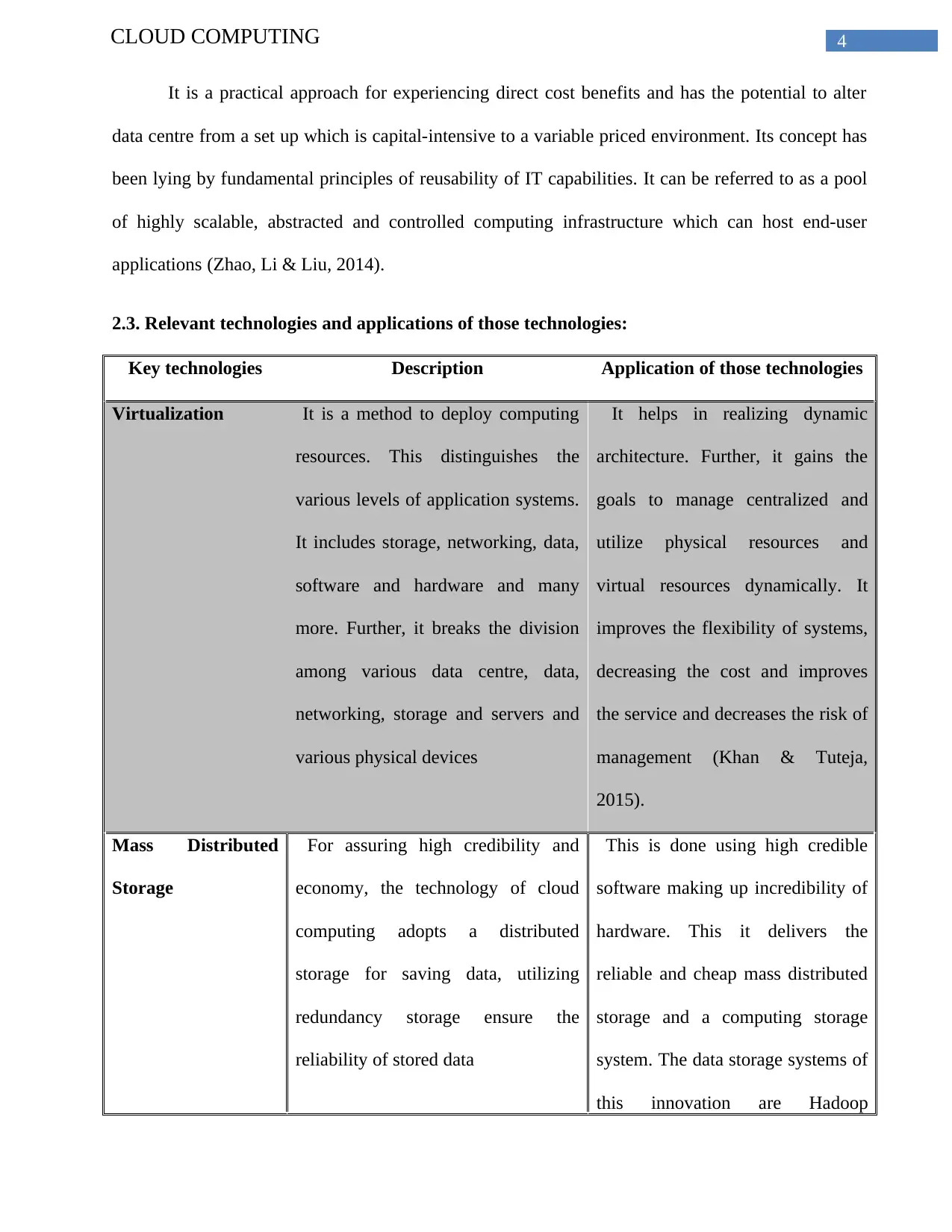
4CLOUD COMPUTING
It is a practical approach for experiencing direct cost benefits and has the potential to alter
data centre from a set up which is capital-intensive to a variable priced environment. Its concept has
been lying by fundamental principles of reusability of IT capabilities. It can be referred to as a pool
of highly scalable, abstracted and controlled computing infrastructure which can host end-user
applications (Zhao, Li & Liu, 2014).
2.3. Relevant technologies and applications of those technologies:
Key technologies Description Application of those technologies
Virtualization It is a method to deploy computing
resources. This distinguishes the
various levels of application systems.
It includes storage, networking, data,
software and hardware and many
more. Further, it breaks the division
among various data centre, data,
networking, storage and servers and
various physical devices
It helps in realizing dynamic
architecture. Further, it gains the
goals to manage centralized and
utilize physical resources and
virtual resources dynamically. It
improves the flexibility of systems,
decreasing the cost and improves
the service and decreases the risk of
management (Khan & Tuteja,
2015).
Mass Distributed
Storage
For assuring high credibility and
economy, the technology of cloud
computing adopts a distributed
storage for saving data, utilizing
redundancy storage ensure the
reliability of stored data
This is done using high credible
software making up incredibility of
hardware. This it delivers the
reliable and cheap mass distributed
storage and a computing storage
system. The data storage systems of
this innovation are Hadoop
It is a practical approach for experiencing direct cost benefits and has the potential to alter
data centre from a set up which is capital-intensive to a variable priced environment. Its concept has
been lying by fundamental principles of reusability of IT capabilities. It can be referred to as a pool
of highly scalable, abstracted and controlled computing infrastructure which can host end-user
applications (Zhao, Li & Liu, 2014).
2.3. Relevant technologies and applications of those technologies:
Key technologies Description Application of those technologies
Virtualization It is a method to deploy computing
resources. This distinguishes the
various levels of application systems.
It includes storage, networking, data,
software and hardware and many
more. Further, it breaks the division
among various data centre, data,
networking, storage and servers and
various physical devices
It helps in realizing dynamic
architecture. Further, it gains the
goals to manage centralized and
utilize physical resources and
virtual resources dynamically. It
improves the flexibility of systems,
decreasing the cost and improves
the service and decreases the risk of
management (Khan & Tuteja,
2015).
Mass Distributed
Storage
For assuring high credibility and
economy, the technology of cloud
computing adopts a distributed
storage for saving data, utilizing
redundancy storage ensure the
reliability of stored data
This is done using high credible
software making up incredibility of
hardware. This it delivers the
reliable and cheap mass distributed
storage and a computing storage
system. The data storage systems of
this innovation are Hadoop
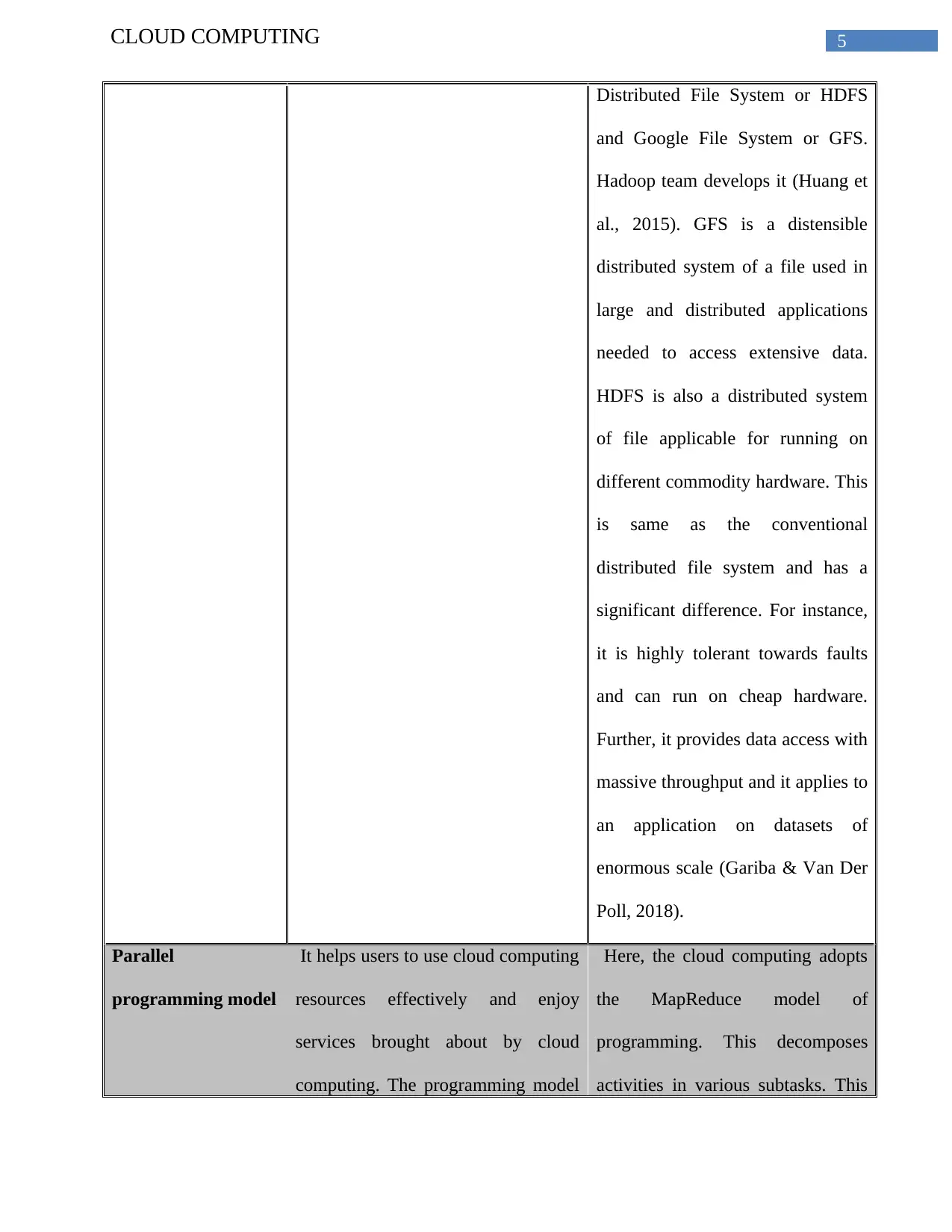
5CLOUD COMPUTING
Distributed File System or HDFS
and Google File System or GFS.
Hadoop team develops it (Huang et
al., 2015). GFS is a distensible
distributed system of a file used in
large and distributed applications
needed to access extensive data.
HDFS is also a distributed system
of file applicable for running on
different commodity hardware. This
is same as the conventional
distributed file system and has a
significant difference. For instance,
it is highly tolerant towards faults
and can run on cheap hardware.
Further, it provides data access with
massive throughput and it applies to
an application on datasets of
enormous scale (Gariba & Van Der
Poll, 2018).
Parallel
programming model
It helps users to use cloud computing
resources effectively and enjoy
services brought about by cloud
computing. The programming model
Here, the cloud computing adopts
the MapReduce model of
programming. This decomposes
activities in various subtasks. This
Distributed File System or HDFS
and Google File System or GFS.
Hadoop team develops it (Huang et
al., 2015). GFS is a distensible
distributed system of a file used in
large and distributed applications
needed to access extensive data.
HDFS is also a distributed system
of file applicable for running on
different commodity hardware. This
is same as the conventional
distributed file system and has a
significant difference. For instance,
it is highly tolerant towards faults
and can run on cheap hardware.
Further, it provides data access with
massive throughput and it applies to
an application on datasets of
enormous scale (Gariba & Van Der
Poll, 2018).
Parallel
programming model
It helps users to use cloud computing
resources effectively and enjoy
services brought about by cloud
computing. The programming model
Here, the cloud computing adopts
the MapReduce model of
programming. This decomposes
activities in various subtasks. This
⊘ This is a preview!⊘
Do you want full access?
Subscribe today to unlock all pages.

Trusted by 1+ million students worldwide
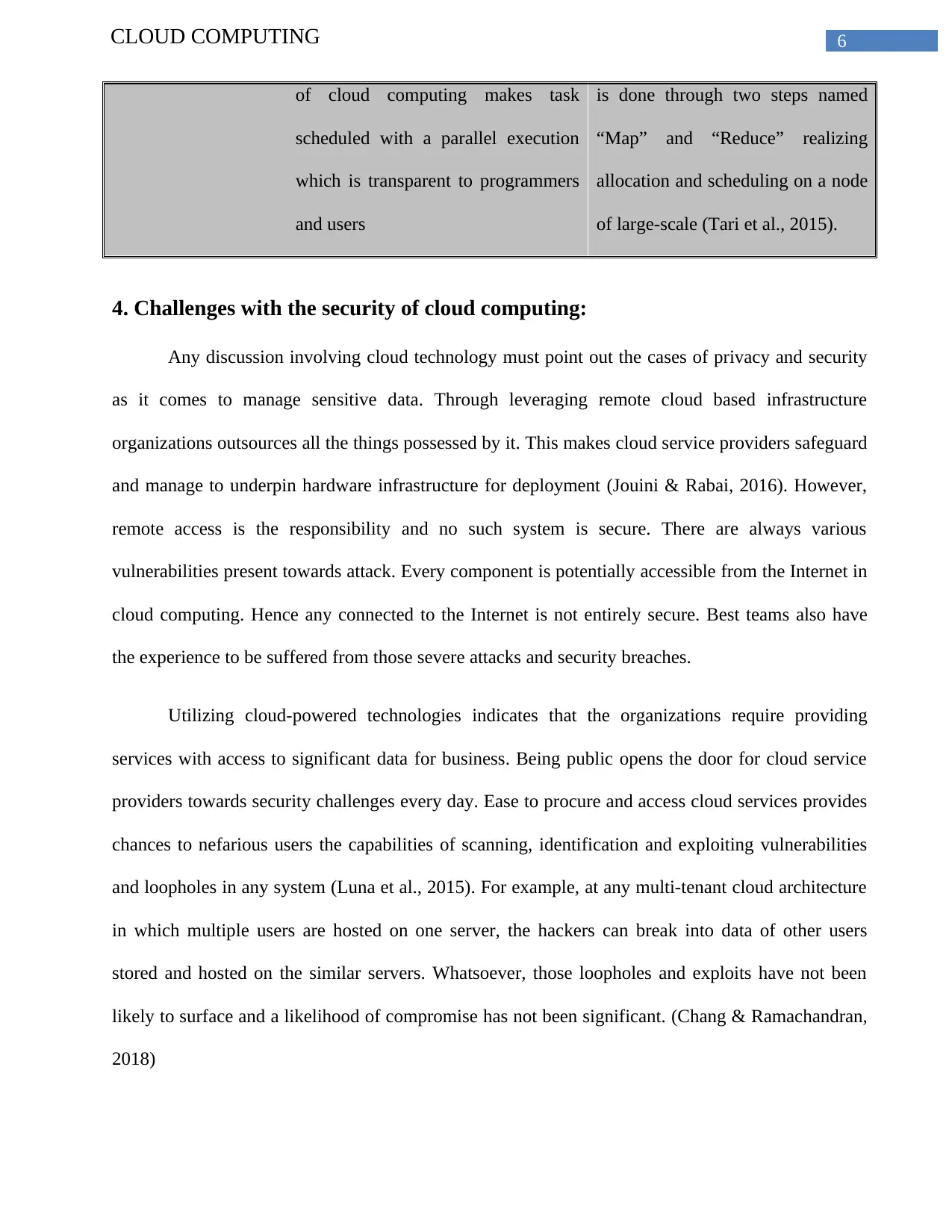
6CLOUD COMPUTING
of cloud computing makes task
scheduled with a parallel execution
which is transparent to programmers
and users
is done through two steps named
“Map” and “Reduce” realizing
allocation and scheduling on a node
of large-scale (Tari et al., 2015).
4. Challenges with the security of cloud computing:
Any discussion involving cloud technology must point out the cases of privacy and security
as it comes to manage sensitive data. Through leveraging remote cloud based infrastructure
organizations outsources all the things possessed by it. This makes cloud service providers safeguard
and manage to underpin hardware infrastructure for deployment (Jouini & Rabai, 2016). However,
remote access is the responsibility and no such system is secure. There are always various
vulnerabilities present towards attack. Every component is potentially accessible from the Internet in
cloud computing. Hence any connected to the Internet is not entirely secure. Best teams also have
the experience to be suffered from those severe attacks and security breaches.
Utilizing cloud-powered technologies indicates that the organizations require providing
services with access to significant data for business. Being public opens the door for cloud service
providers towards security challenges every day. Ease to procure and access cloud services provides
chances to nefarious users the capabilities of scanning, identification and exploiting vulnerabilities
and loopholes in any system (Luna et al., 2015). For example, at any multi-tenant cloud architecture
in which multiple users are hosted on one server, the hackers can break into data of other users
stored and hosted on the similar servers. Whatsoever, those loopholes and exploits have not been
likely to surface and a likelihood of compromise has not been significant. (Chang & Ramachandran,
2018)
of cloud computing makes task
scheduled with a parallel execution
which is transparent to programmers
and users
is done through two steps named
“Map” and “Reduce” realizing
allocation and scheduling on a node
of large-scale (Tari et al., 2015).
4. Challenges with the security of cloud computing:
Any discussion involving cloud technology must point out the cases of privacy and security
as it comes to manage sensitive data. Through leveraging remote cloud based infrastructure
organizations outsources all the things possessed by it. This makes cloud service providers safeguard
and manage to underpin hardware infrastructure for deployment (Jouini & Rabai, 2016). However,
remote access is the responsibility and no such system is secure. There are always various
vulnerabilities present towards attack. Every component is potentially accessible from the Internet in
cloud computing. Hence any connected to the Internet is not entirely secure. Best teams also have
the experience to be suffered from those severe attacks and security breaches.
Utilizing cloud-powered technologies indicates that the organizations require providing
services with access to significant data for business. Being public opens the door for cloud service
providers towards security challenges every day. Ease to procure and access cloud services provides
chances to nefarious users the capabilities of scanning, identification and exploiting vulnerabilities
and loopholes in any system (Luna et al., 2015). For example, at any multi-tenant cloud architecture
in which multiple users are hosted on one server, the hackers can break into data of other users
stored and hosted on the similar servers. Whatsoever, those loopholes and exploits have not been
likely to surface and a likelihood of compromise has not been significant. (Chang & Ramachandran,
2018)
Paraphrase This Document
Need a fresh take? Get an instant paraphrase of this document with our AI Paraphraser
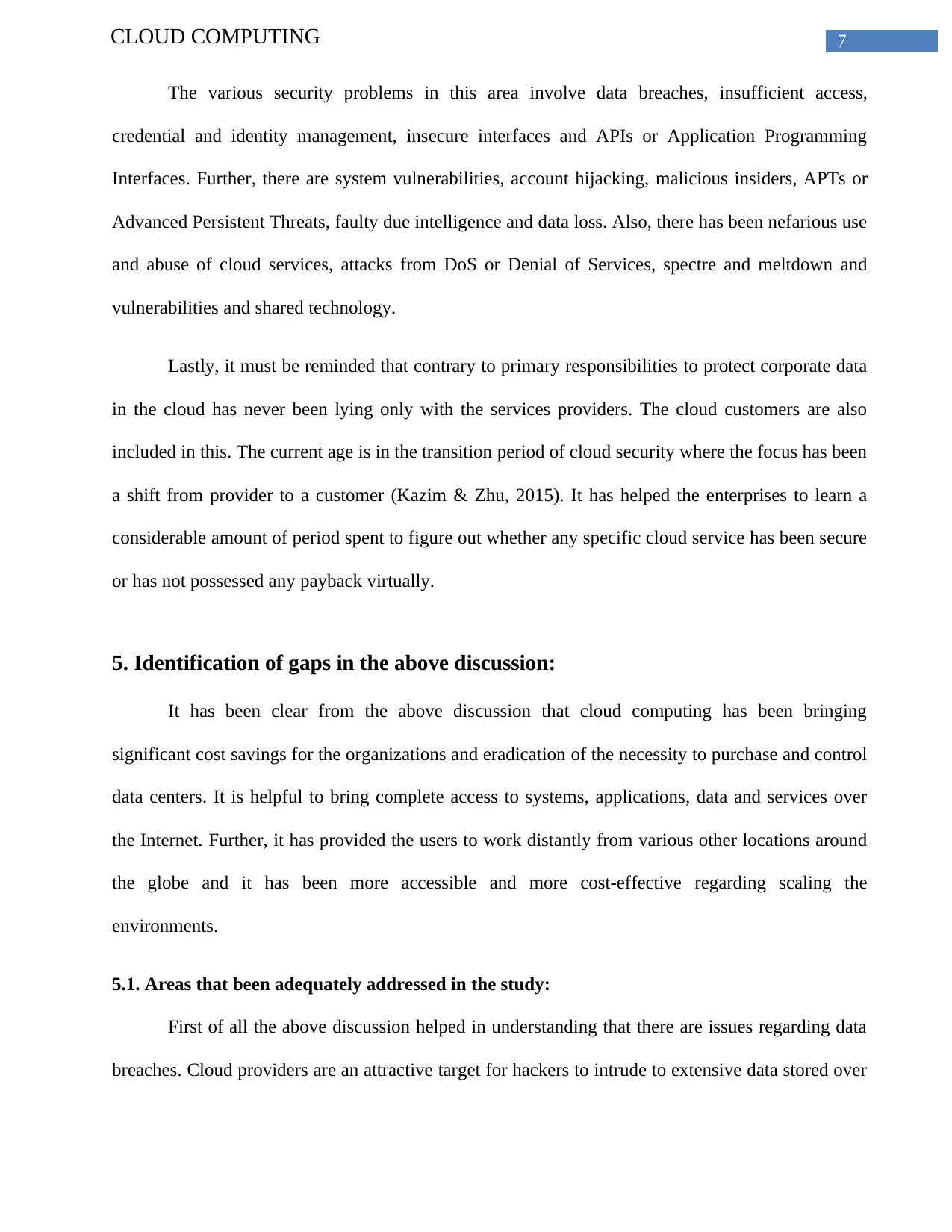
7CLOUD COMPUTING
The various security problems in this area involve data breaches, insufficient access,
credential and identity management, insecure interfaces and APIs or Application Programming
Interfaces. Further, there are system vulnerabilities, account hijacking, malicious insiders, APTs or
Advanced Persistent Threats, faulty due intelligence and data loss. Also, there has been nefarious use
and abuse of cloud services, attacks from DoS or Denial of Services, spectre and meltdown and
vulnerabilities and shared technology.
Lastly, it must be reminded that contrary to primary responsibilities to protect corporate data
in the cloud has never been lying only with the services providers. The cloud customers are also
included in this. The current age is in the transition period of cloud security where the focus has been
a shift from provider to a customer (Kazim & Zhu, 2015). It has helped the enterprises to learn a
considerable amount of period spent to figure out whether any specific cloud service has been secure
or has not possessed any payback virtually.
5. Identification of gaps in the above discussion:
It has been clear from the above discussion that cloud computing has been bringing
significant cost savings for the organizations and eradication of the necessity to purchase and control
data centers. It is helpful to bring complete access to systems, applications, data and services over
the Internet. Further, it has provided the users to work distantly from various other locations around
the globe and it has been more accessible and more cost-effective regarding scaling the
environments.
5.1. Areas that been adequately addressed in the study:
First of all the above discussion helped in understanding that there are issues regarding data
breaches. Cloud providers are an attractive target for hackers to intrude to extensive data stored over
The various security problems in this area involve data breaches, insufficient access,
credential and identity management, insecure interfaces and APIs or Application Programming
Interfaces. Further, there are system vulnerabilities, account hijacking, malicious insiders, APTs or
Advanced Persistent Threats, faulty due intelligence and data loss. Also, there has been nefarious use
and abuse of cloud services, attacks from DoS or Denial of Services, spectre and meltdown and
vulnerabilities and shared technology.
Lastly, it must be reminded that contrary to primary responsibilities to protect corporate data
in the cloud has never been lying only with the services providers. The cloud customers are also
included in this. The current age is in the transition period of cloud security where the focus has been
a shift from provider to a customer (Kazim & Zhu, 2015). It has helped the enterprises to learn a
considerable amount of period spent to figure out whether any specific cloud service has been secure
or has not possessed any payback virtually.
5. Identification of gaps in the above discussion:
It has been clear from the above discussion that cloud computing has been bringing
significant cost savings for the organizations and eradication of the necessity to purchase and control
data centers. It is helpful to bring complete access to systems, applications, data and services over
the Internet. Further, it has provided the users to work distantly from various other locations around
the globe and it has been more accessible and more cost-effective regarding scaling the
environments.
5.1. Areas that been adequately addressed in the study:
First of all the above discussion helped in understanding that there are issues regarding data
breaches. Cloud providers are an attractive target for hackers to intrude to extensive data stored over
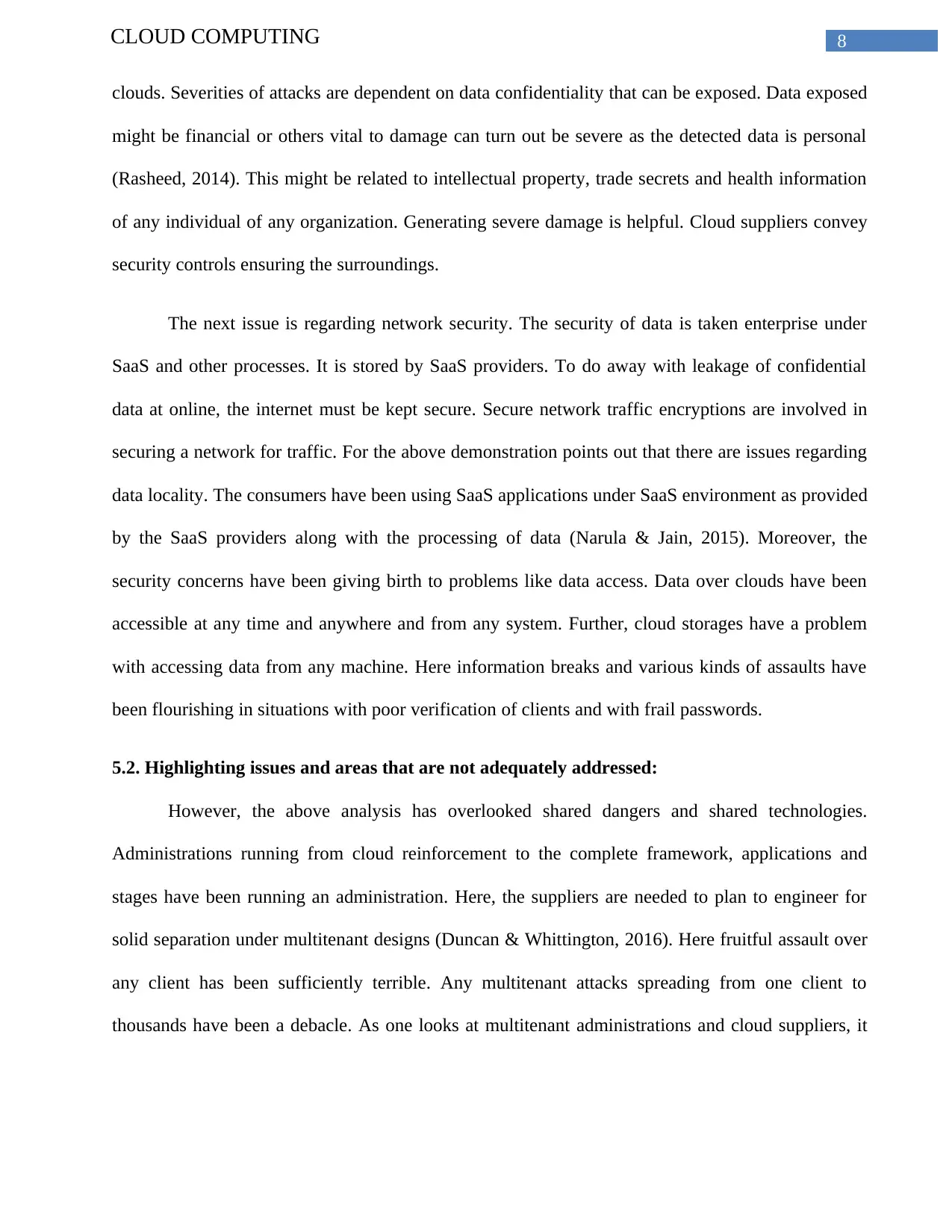
8CLOUD COMPUTING
clouds. Severities of attacks are dependent on data confidentiality that can be exposed. Data exposed
might be financial or others vital to damage can turn out be severe as the detected data is personal
(Rasheed, 2014). This might be related to intellectual property, trade secrets and health information
of any individual of any organization. Generating severe damage is helpful. Cloud suppliers convey
security controls ensuring the surroundings.
The next issue is regarding network security. The security of data is taken enterprise under
SaaS and other processes. It is stored by SaaS providers. To do away with leakage of confidential
data at online, the internet must be kept secure. Secure network traffic encryptions are involved in
securing a network for traffic. For the above demonstration points out that there are issues regarding
data locality. The consumers have been using SaaS applications under SaaS environment as provided
by the SaaS providers along with the processing of data (Narula & Jain, 2015). Moreover, the
security concerns have been giving birth to problems like data access. Data over clouds have been
accessible at any time and anywhere and from any system. Further, cloud storages have a problem
with accessing data from any machine. Here information breaks and various kinds of assaults have
been flourishing in situations with poor verification of clients and with frail passwords.
5.2. Highlighting issues and areas that are not adequately addressed:
However, the above analysis has overlooked shared dangers and shared technologies.
Administrations running from cloud reinforcement to the complete framework, applications and
stages have been running an administration. Here, the suppliers are needed to plan to engineer for
solid separation under multitenant designs (Duncan & Whittington, 2016). Here fruitful assault over
any client has been sufficiently terrible. Any multitenant attacks spreading from one client to
thousands have been a debacle. As one looks at multitenant administrations and cloud suppliers, it
clouds. Severities of attacks are dependent on data confidentiality that can be exposed. Data exposed
might be financial or others vital to damage can turn out be severe as the detected data is personal
(Rasheed, 2014). This might be related to intellectual property, trade secrets and health information
of any individual of any organization. Generating severe damage is helpful. Cloud suppliers convey
security controls ensuring the surroundings.
The next issue is regarding network security. The security of data is taken enterprise under
SaaS and other processes. It is stored by SaaS providers. To do away with leakage of confidential
data at online, the internet must be kept secure. Secure network traffic encryptions are involved in
securing a network for traffic. For the above demonstration points out that there are issues regarding
data locality. The consumers have been using SaaS applications under SaaS environment as provided
by the SaaS providers along with the processing of data (Narula & Jain, 2015). Moreover, the
security concerns have been giving birth to problems like data access. Data over clouds have been
accessible at any time and anywhere and from any system. Further, cloud storages have a problem
with accessing data from any machine. Here information breaks and various kinds of assaults have
been flourishing in situations with poor verification of clients and with frail passwords.
5.2. Highlighting issues and areas that are not adequately addressed:
However, the above analysis has overlooked shared dangers and shared technologies.
Administrations running from cloud reinforcement to the complete framework, applications and
stages have been running an administration. Here, the suppliers are needed to plan to engineer for
solid separation under multitenant designs (Duncan & Whittington, 2016). Here fruitful assault over
any client has been sufficiently terrible. Any multitenant attacks spreading from one client to
thousands have been a debacle. As one looks at multitenant administrations and cloud suppliers, it
⊘ This is a preview!⊘
Do you want full access?
Subscribe today to unlock all pages.

Trusted by 1+ million students worldwide
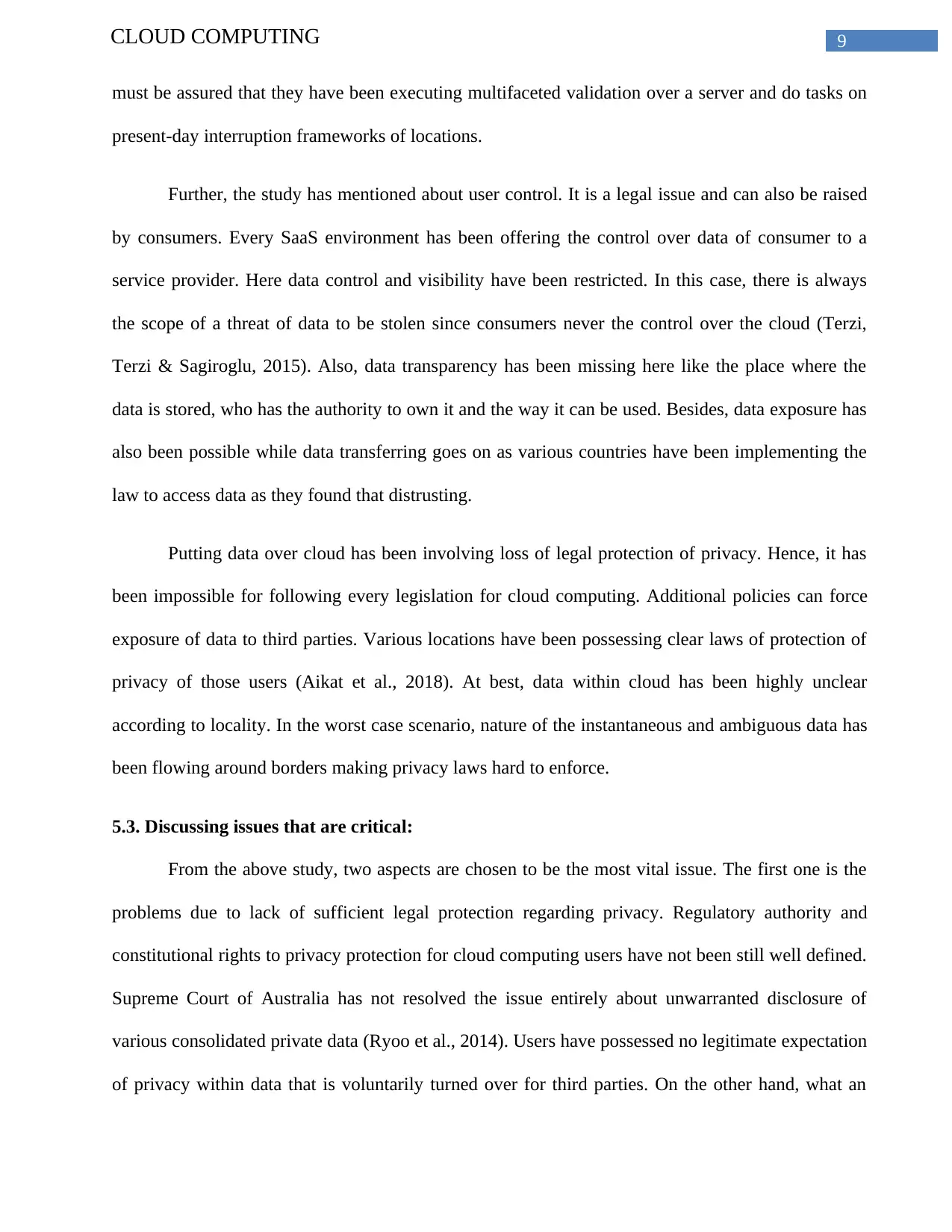
9CLOUD COMPUTING
must be assured that they have been executing multifaceted validation over a server and do tasks on
present-day interruption frameworks of locations.
Further, the study has mentioned about user control. It is a legal issue and can also be raised
by consumers. Every SaaS environment has been offering the control over data of consumer to a
service provider. Here data control and visibility have been restricted. In this case, there is always
the scope of a threat of data to be stolen since consumers never the control over the cloud (Terzi,
Terzi & Sagiroglu, 2015). Also, data transparency has been missing here like the place where the
data is stored, who has the authority to own it and the way it can be used. Besides, data exposure has
also been possible while data transferring goes on as various countries have been implementing the
law to access data as they found that distrusting.
Putting data over cloud has been involving loss of legal protection of privacy. Hence, it has
been impossible for following every legislation for cloud computing. Additional policies can force
exposure of data to third parties. Various locations have been possessing clear laws of protection of
privacy of those users (Aikat et al., 2018). At best, data within cloud has been highly unclear
according to locality. In the worst case scenario, nature of the instantaneous and ambiguous data has
been flowing around borders making privacy laws hard to enforce.
5.3. Discussing issues that are critical:
From the above study, two aspects are chosen to be the most vital issue. The first one is the
problems due to lack of sufficient legal protection regarding privacy. Regulatory authority and
constitutional rights to privacy protection for cloud computing users have not been still well defined.
Supreme Court of Australia has not resolved the issue entirely about unwarranted disclosure of
various consolidated private data (Ryoo et al., 2014). Users have possessed no legitimate expectation
of privacy within data that is voluntarily turned over for third parties. On the other hand, what an
must be assured that they have been executing multifaceted validation over a server and do tasks on
present-day interruption frameworks of locations.
Further, the study has mentioned about user control. It is a legal issue and can also be raised
by consumers. Every SaaS environment has been offering the control over data of consumer to a
service provider. Here data control and visibility have been restricted. In this case, there is always
the scope of a threat of data to be stolen since consumers never the control over the cloud (Terzi,
Terzi & Sagiroglu, 2015). Also, data transparency has been missing here like the place where the
data is stored, who has the authority to own it and the way it can be used. Besides, data exposure has
also been possible while data transferring goes on as various countries have been implementing the
law to access data as they found that distrusting.
Putting data over cloud has been involving loss of legal protection of privacy. Hence, it has
been impossible for following every legislation for cloud computing. Additional policies can force
exposure of data to third parties. Various locations have been possessing clear laws of protection of
privacy of those users (Aikat et al., 2018). At best, data within cloud has been highly unclear
according to locality. In the worst case scenario, nature of the instantaneous and ambiguous data has
been flowing around borders making privacy laws hard to enforce.
5.3. Discussing issues that are critical:
From the above study, two aspects are chosen to be the most vital issue. The first one is the
problems due to lack of sufficient legal protection regarding privacy. Regulatory authority and
constitutional rights to privacy protection for cloud computing users have not been still well defined.
Supreme Court of Australia has not resolved the issue entirely about unwarranted disclosure of
various consolidated private data (Ryoo et al., 2014). Users have possessed no legitimate expectation
of privacy within data that is voluntarily turned over for third parties. On the other hand, what an
Paraphrase This Document
Need a fresh take? Get an instant paraphrase of this document with our AI Paraphraser
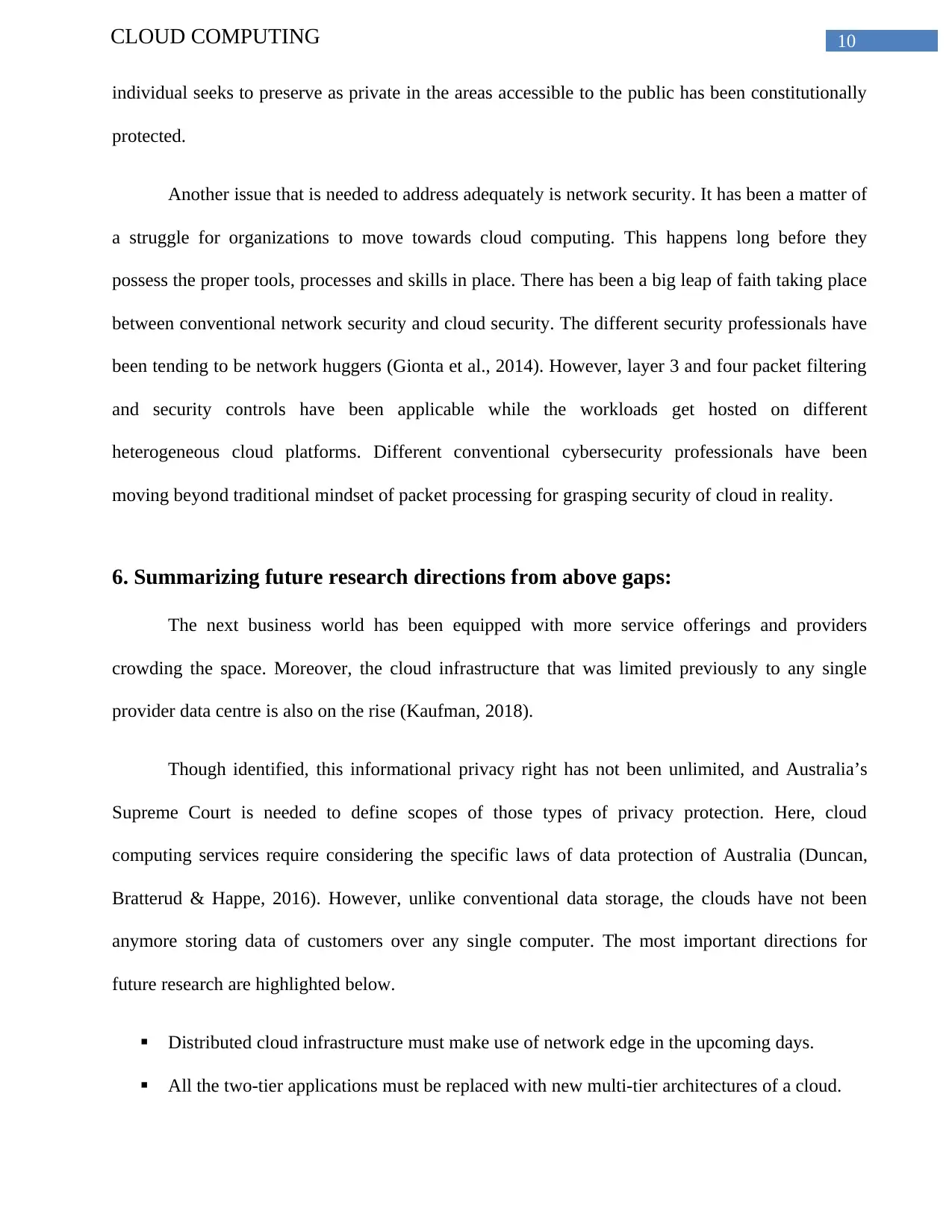
10CLOUD COMPUTING
individual seeks to preserve as private in the areas accessible to the public has been constitutionally
protected.
Another issue that is needed to address adequately is network security. It has been a matter of
a struggle for organizations to move towards cloud computing. This happens long before they
possess the proper tools, processes and skills in place. There has been a big leap of faith taking place
between conventional network security and cloud security. The different security professionals have
been tending to be network huggers (Gionta et al., 2014). However, layer 3 and four packet filtering
and security controls have been applicable while the workloads get hosted on different
heterogeneous cloud platforms. Different conventional cybersecurity professionals have been
moving beyond traditional mindset of packet processing for grasping security of cloud in reality.
6. Summarizing future research directions from above gaps:
The next business world has been equipped with more service offerings and providers
crowding the space. Moreover, the cloud infrastructure that was limited previously to any single
provider data centre is also on the rise (Kaufman, 2018).
Though identified, this informational privacy right has not been unlimited, and Australia’s
Supreme Court is needed to define scopes of those types of privacy protection. Here, cloud
computing services require considering the specific laws of data protection of Australia (Duncan,
Bratterud & Happe, 2016). However, unlike conventional data storage, the clouds have not been
anymore storing data of customers over any single computer. The most important directions for
future research are highlighted below.
Distributed cloud infrastructure must make use of network edge in the upcoming days.
All the two-tier applications must be replaced with new multi-tier architectures of a cloud.
individual seeks to preserve as private in the areas accessible to the public has been constitutionally
protected.
Another issue that is needed to address adequately is network security. It has been a matter of
a struggle for organizations to move towards cloud computing. This happens long before they
possess the proper tools, processes and skills in place. There has been a big leap of faith taking place
between conventional network security and cloud security. The different security professionals have
been tending to be network huggers (Gionta et al., 2014). However, layer 3 and four packet filtering
and security controls have been applicable while the workloads get hosted on different
heterogeneous cloud platforms. Different conventional cybersecurity professionals have been
moving beyond traditional mindset of packet processing for grasping security of cloud in reality.
6. Summarizing future research directions from above gaps:
The next business world has been equipped with more service offerings and providers
crowding the space. Moreover, the cloud infrastructure that was limited previously to any single
provider data centre is also on the rise (Kaufman, 2018).
Though identified, this informational privacy right has not been unlimited, and Australia’s
Supreme Court is needed to define scopes of those types of privacy protection. Here, cloud
computing services require considering the specific laws of data protection of Australia (Duncan,
Bratterud & Happe, 2016). However, unlike conventional data storage, the clouds have not been
anymore storing data of customers over any single computer. The most important directions for
future research are highlighted below.
Distributed cloud infrastructure must make use of network edge in the upcoming days.
All the two-tier applications must be replaced with new multi-tier architectures of a cloud.
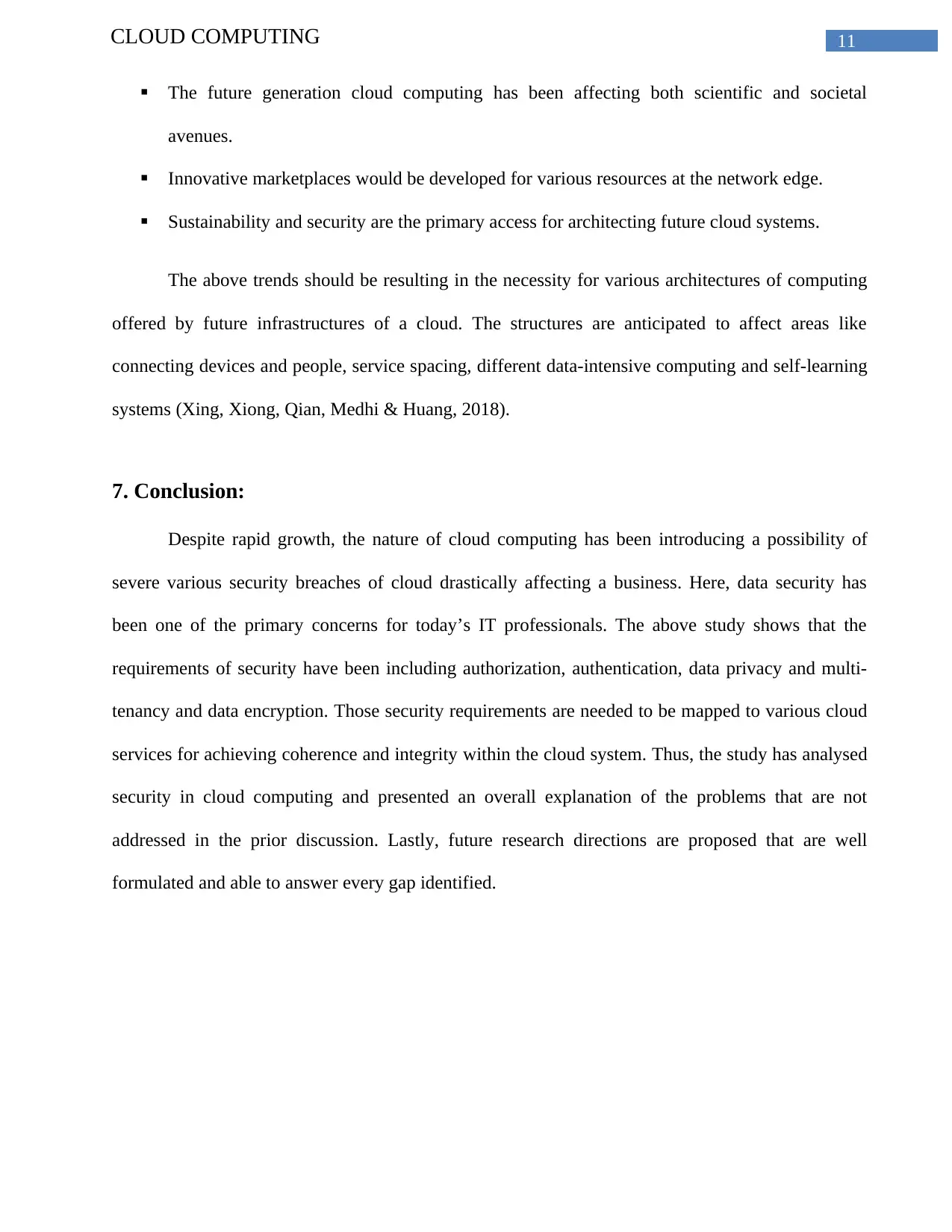
11CLOUD COMPUTING
The future generation cloud computing has been affecting both scientific and societal
avenues.
Innovative marketplaces would be developed for various resources at the network edge.
Sustainability and security are the primary access for architecting future cloud systems.
The above trends should be resulting in the necessity for various architectures of computing
offered by future infrastructures of a cloud. The structures are anticipated to affect areas like
connecting devices and people, service spacing, different data-intensive computing and self-learning
systems (Xing, Xiong, Qian, Medhi & Huang, 2018).
7. Conclusion:
Despite rapid growth, the nature of cloud computing has been introducing a possibility of
severe various security breaches of cloud drastically affecting a business. Here, data security has
been one of the primary concerns for today’s IT professionals. The above study shows that the
requirements of security have been including authorization, authentication, data privacy and multi-
tenancy and data encryption. Those security requirements are needed to be mapped to various cloud
services for achieving coherence and integrity within the cloud system. Thus, the study has analysed
security in cloud computing and presented an overall explanation of the problems that are not
addressed in the prior discussion. Lastly, future research directions are proposed that are well
formulated and able to answer every gap identified.
The future generation cloud computing has been affecting both scientific and societal
avenues.
Innovative marketplaces would be developed for various resources at the network edge.
Sustainability and security are the primary access for architecting future cloud systems.
The above trends should be resulting in the necessity for various architectures of computing
offered by future infrastructures of a cloud. The structures are anticipated to affect areas like
connecting devices and people, service spacing, different data-intensive computing and self-learning
systems (Xing, Xiong, Qian, Medhi & Huang, 2018).
7. Conclusion:
Despite rapid growth, the nature of cloud computing has been introducing a possibility of
severe various security breaches of cloud drastically affecting a business. Here, data security has
been one of the primary concerns for today’s IT professionals. The above study shows that the
requirements of security have been including authorization, authentication, data privacy and multi-
tenancy and data encryption. Those security requirements are needed to be mapped to various cloud
services for achieving coherence and integrity within the cloud system. Thus, the study has analysed
security in cloud computing and presented an overall explanation of the problems that are not
addressed in the prior discussion. Lastly, future research directions are proposed that are well
formulated and able to answer every gap identified.
⊘ This is a preview!⊘
Do you want full access?
Subscribe today to unlock all pages.

Trusted by 1+ million students worldwide
1 out of 15
Related Documents
Your All-in-One AI-Powered Toolkit for Academic Success.
+13062052269
info@desklib.com
Available 24*7 on WhatsApp / Email
![[object Object]](/_next/static/media/star-bottom.7253800d.svg)
Unlock your academic potential
Copyright © 2020–2025 A2Z Services. All Rights Reserved. Developed and managed by ZUCOL.



